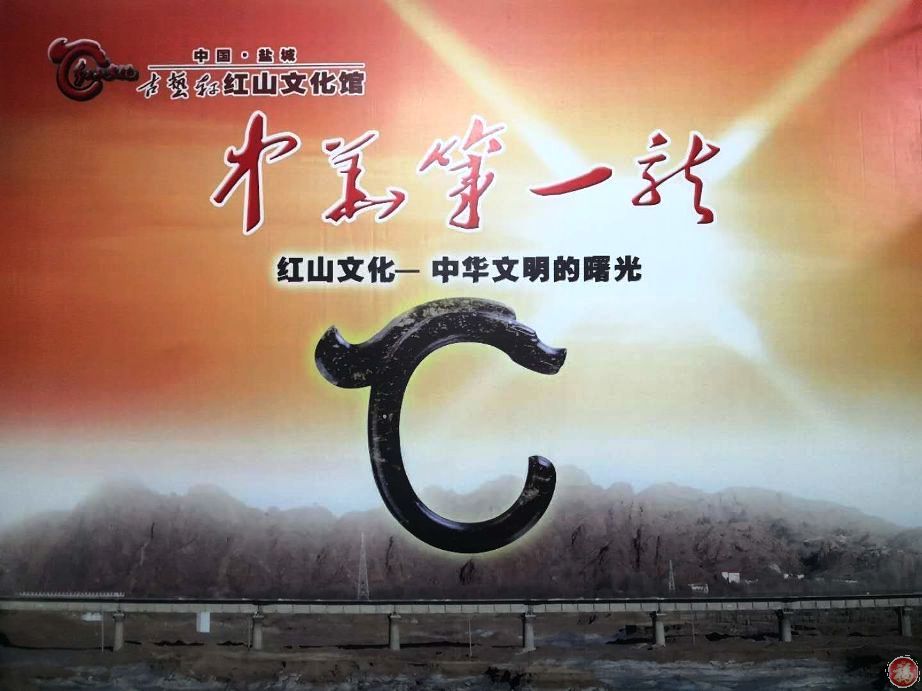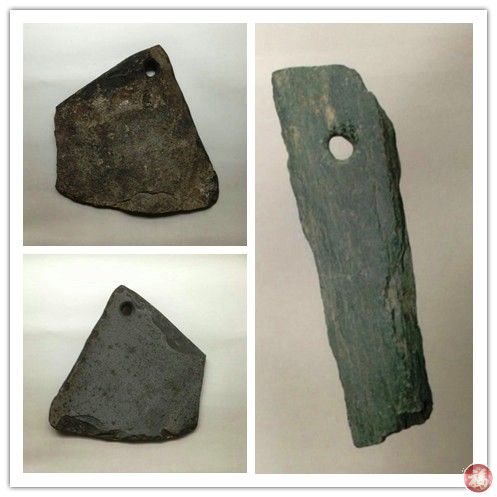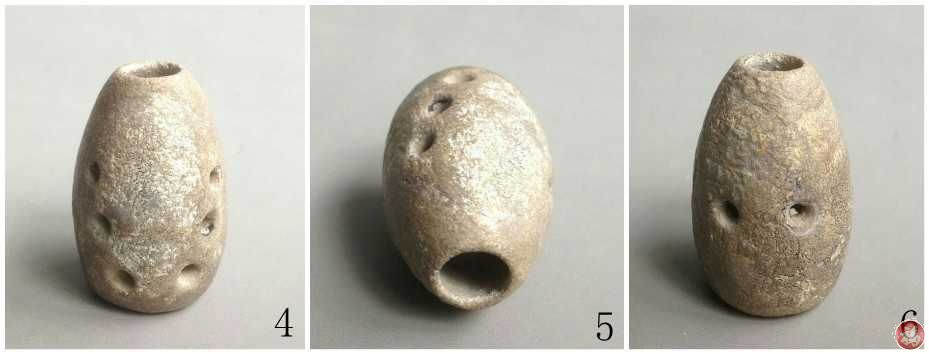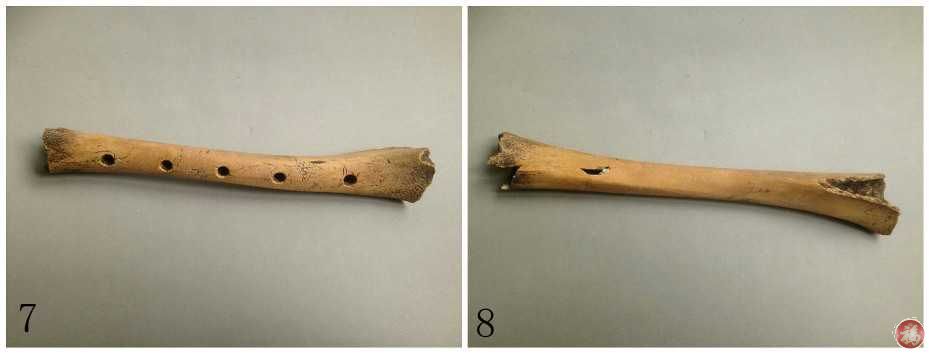|

红山石磬、石埙、骨笛的文化解读
乔木 周阳生
红山文化犹如一部天书,蕴藏着无数的神奇密码,后人在研究中逐步发现,红山文化蕴涵着中华民族五千年前的文明发展、艺术发展、宗教发展、哲学发展、科学技术发展等诸多元素,而众多红山物证的出现也佐证了这一多元文化的实际存在。下文笔者就乔木馆藏的红山石磬、石埙、骨笛进行一些粗浅的文化解读,以供专家学者参考。
一、乔木馆藏红山石磬的鉴定与解读

红山石磬(从右至左 图1 图2上 图3下)
本文所列的乔木馆藏红山石磬三块,均由考古专家车广锦先生鉴定为红山石磬真品(见图1、2、3)。图1长石磬,长27cm、宽6.3cm、宽3.5cm,打制器,距今约8000年左右。红山磬是用石头磨制,其起源应溯到石器时代。先人们应是在磨制石具的实践中,发现到不同石块受打击时会发出不同的声音,因此受到启发而开始磨石为磬。最初可能是用普通石头磨制,后来逐渐采用一些特殊石头或玉石制成各种发固定单音的磬,再后来又发展成为具有几个至一系列固定音的编磬。这是关于“磬”来历的“劳动产生说”。
磬的历史悠久,在红山母系氏族社会,磬曾被称为“石”和“鸣球”,当时人们以渔猎为生,劳动之后敲击石头,装扮成各种野兽的形象跳舞娱乐。这种敲击的石头就逐渐演变为后来的打击乐器—磬。这是关于“磬”来历的“娱乐产生说”。
据先秦文献《尚书·益稷》记载:“戛击鸣球”,鸣球磬也。又据《世本·作篇》记载:传说尧舜做部落联盟酋长时,已在祭祀礼仪中使用磬。《吕氏春秋·古乐篇》中也有记载:尧命夔击磬“以象上帝”、“以致舞百兽”,描绘出一幅古老原始社会的乐舞生活场景。再从殷墟出土的甲骨文来看,磬的左半部像“以绳悬石”,右半部像“人执槌击”状。磬的种类很多,有玉磬、铁磬、铜磬、编磬、笙磬、颂磬、歌磬、云磬、特磬等。古代主要用编磬(宫廷礼乐和祭典用)、云磬(佛家法器)、特磬(皇帝祭祀时按月用选用的乐器)。总之在古代,“磬”是一种神圣的器物。
二、乔木馆藏红山石埙的鉴定与解读
乔木馆藏的石埙,高5cm、直径3.3cm。一面可见八字分布、各3个孔,另一面2个横排孔。(见图4、5、6)车广锦先生鉴定为红山晚期夏家店下层文化真品。这只石埙,如今吹奏,音质如初,天籁之音极尽忧思之情,是研究中国音乐史的重要物证之一。

图4:石埙 图5:石埙卧面 图6:石埙背面
1956年,在西安半坡遗址中曾首先发现两只6000年前土烧的陶埙。一只是上下贯穿一孔,一只是只有一个吹孔,经专家测试为单音孔埙,是典型的吹奏乐器,是我国历史上埙的最早形式。
有专家认为,商周以后多孔音埙才出现,到了春秋时期,埙已经成为专家演奏雅乐的主要乐器之一。然红山晚期的这只多孔石埙的出现,填补了商周之前无多孔音埙发现的空白。
三、乔木馆藏红山骨笛的鉴定与解读
乔木馆藏的骨笛长17.2cm,两头宽2.7cm,中腰直径1.5cm(见图7、8)。该骨笛,音孔开挖精细,似有开挖音孔1对的比例刻线。经车广锦先生鉴定为新石器时代的骨笛,距今应有8000年以上。

图7:骨笛(正面) 图8:骨笛(背面)
1987年在河南舞阳贾湖也出土过一批新石器时代的骨笛,经“碳十四同位素放射”及“树轮校正”等相关测试,这批骨笛距今有8000年至9000年历史,被誉为“中华第一笛”。这批出土的骨笛共有21支,有五孔、七孔、八孔之分,长约20cm左右,系用猛禽的骨管制成。类似的骨笛在浙江河姆渡也曾出土过160多件,距今7000年左右。
以上出土的骨笛实物证明:中国的笛子,绝不是有些音乐书籍所记述的,是由汉代张骞出使西域而引进的,而应是张骞出使西域而输出的。
其实在汉代以前笛子就已广泛流传,许多出土的汉代画像砖上就有吹笛乐手形象,更何况还有舞阳、河姆渡、红山出土的骨笛。
根据《吕氏春秋》、《玉海》等文献中曾记载黄帝命令伶伦伐昆仑之竹为笛的传说,这可能就是最早出现的竹笛。唐朝时一个名叫刘系的艺人又将竹笛贴膜以助发声。到了宋朝以后,又出现了吹孔在中间、两手交叉演奏的“叉手笛”。宋朝之后,就和现在的竹笛形无二制了。
通过对上述古代乐器的解读,不难看出乐器从远古时期开始就伴随着人类的文明发展史在演变,古代的乐器发展史人类文明发展史的一个不可或缺的有机组成部分。

译文如下:
Cultural Interpretation of chime stones,
stone wind instrument and bone flutes of
Hongshan culture preserved
by Mr. Qiao Mu
Hongshan culture is a sealed book,
which contains numerous magic codes
to crack down.
Studies have found clues of the culture,
art, religion,
philosophy and science of China dating
back to five thousand years ago can be
tracked down in Hongshan culture.
Meanwhile,
material evidence of
Hongshan culture has been unearthed,
proving its existence.
The authors made a cultural interpretation
of chime stones, stone wind instruments and
bone flutes of Hongshan culture preserved
by Mr. Qiao Mu.
I.
Identification and interpretation
of chime stones

Chime stones of Hongshan culture
(right to left Pic 1 Pic 2up Pic 3 down)
The three chime stones were identified as
genuine articles by Mr. Che Guangjing,
a Chinese archaeological expert
(see Figure 1, 2 and 3).
The long stone in Figure 1, 27cm long ,
6.3cm wide
and 3.5cm high, dates back to
about 8,000 years ago.
Chime stones of Hongshan culture can
be traced back to the Stone Age.
The ancestors found in practice that
sounds arose from stones hitting one another.
Inspired by that, chimes stones were invented.
Materials evolved from ordinary stones,
special ones or jades which
chanted single tones,
and were later made into a series of tones.
This is one legend where chime
stones originate from labor.
Chime stones enjoy a long history.
Dating back to the matriarchal society
of Hongshan culture,
people hunted and fished for a living.
After a day’s work,
they liked to hit stones
and dance dressed up as beasts.
The stones gradually evolved
into chime ones.
This is another legend where chime
stones originated from entertainment.
Chime stones were even written
in the literature of Qin Dynasty.
According to one legend, Yao and Shun,
two Chinese ancient sages,
put chime stones into use
in the wordship
ceremony while as tribal alliance chiefs.
Mister Lv’s Spring and Autumn Annals,
one of masterpieces in Qin Dynasty,
depicted a scene of music and dance
in the primitive society.
Inscriptions of chime bone
in Chinese character on bones or
tortoise shells of the Shang Dynasty
(16th-11th century B.C.)
are shaped like stones hanging o
n the rope on the left and a
person striking
stone with mallets on the right.
There exist quite a few chime stones,
like arranged chimes for court ritual
and ceremonial,
Cloud Chime as Buddhist instruments,
Special Chime for worship by emperors on a
monthly basis.
In short,
chime stone is a sacred artifact
in ancient times.
II.
Identification and interpretation
of stone wind instrument
Stone wind instrument is 5cm high
and 3.3cm in diameter.
On the front are laid out six holes
shaped like eight in Chinese character,
and the back is dotted by two holes
in parallel.
(See Fig. 4, 5 and 6).
It has been confirmed by Mr.
Che Guangjing as the artifact
in late period of Hongshan Culture.
It can be played as well as ever,
thus as one of the key evidence
of Chinese Music History.

Figure 4:
stone wind instrument
Figure 5:
wind instrument of stone lying down
Figure 6:
Back of wind instrument of stone
In 1956,
two clay wind instruments \
as early as 6,000 years ago
were discovered in the
Xi’an Banpo ruins,
identified as single-tone
instrument with one hole
and the earliest form
of wind instrument in China.
It is believed that stone wind instrument
of multiple tones didn’t turn up
until Shang and Zhou Dynasties.
In Spring and Autumn Period,
it was one of the key instruments
performing court music for ceremonies.
However, the stone wind instrument
of Hongshan culture filled
the gap of porous sound
before Shang and Zhou Dynasties.
III.
Identification
and interpretation of bone flutes
The bone flute is 17.2cm long,
2.7cm wide at both ends and 1.5cm
in diameter at the center
(see Figure 7 and 8).
Holes of the bone
flute are exquisitely made,
w identified as the
one of the Neolithic Age,
dating back to more
than 8,000 years ago.

Figure 7: the front
Figure 8: the back
In 1987,
bone flutes of the Neolithic
Age were unearthed in Henan,
the ones with a history of
8,000 to 9,000 years
identified by "14C radiation" and
"tree-ring correction”,
known as "No.1 Chinese flutes".
The bone flutes unearthed totaled 21,
typed five holes,
seven holes and eight holes,
about 20cm long, made of raptors’
bones. A total of 160 bone
flutes alike were unearthed
in Zhejiang,
dating back about 7,000 years ago.
The bone flutes unearthed
prove that Chinese flutes were
exported to western regions by
Zhang Qian, a well-known explorer,
traveler and diplomat
in the Han Dynasty,
rather than imported
by him according to some books
on Chinese music.
In fact,
flutes gained its popularity
before the Han Dynasty,
and portrait bricks of the Han Dynasty
unearthed were carved with
images of musicians playing the flute,
not to mention flutes of
Hongshan cultures and the like.
It is a legend in some ancient
Chinese literature that someone was
ordered by Yellow Emperor to cut
bamboos to make flutes out of them,
probably the earliest flutes.
In Tang Dynasty, Liu Xi, an artist,
filmed flutes to make a sound.
It is not until Song Dynasty that
the flute with the blow hole
in the middle, performed by hands
in turn, showed up,
which is quite the same
as the ones nowadays.
In conclusion, musical
instruments have been evolving
along with human civilization
as of ancient times.
The history of evolution of
ancient instruments is
an integral part of
human civilization.

Figure 9:
Mr. Che Guangjing
examined the artifacts
of Yangfotang Hongshan
Jade Gallery founded by Mr. Qiao Mu
September 3, 2015
Links
[About the Author]
Qiao Mu: member of the China
Collectors Association,
director of collection
and research club of Hongshan
jade of the China Institute of
Culture Management,
director of Guyixuan
Hongshan Culture Museum and
director of Yangfotang Hongshan
Jade Gallery.
Tel: 18905102588;
E-mail: 2919866606@qq.com
Zhou Yangsheng:
cultural scholar,
consultant of Ming Yang Museum of Art.


|

